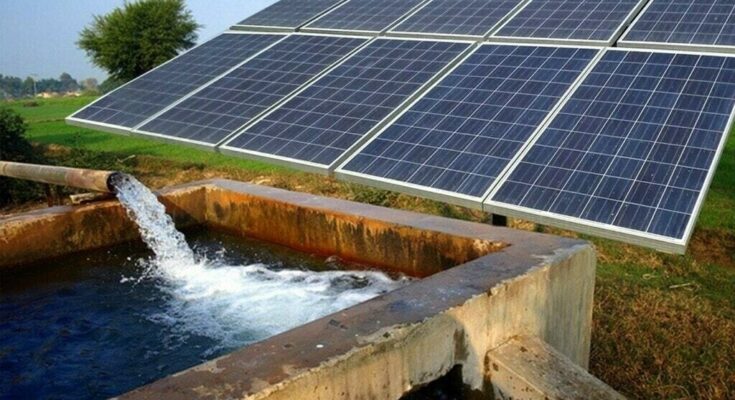Introduction
Agriculture is the backbone of many economies, particularly in developing nations where it supports millions of livelihoods. However, the sector faces significant challenges, including unreliable energy access, rising fuel costs, and environmental degradation. Tube wells, widely used for irrigation, traditionally rely on diesel or grid electricity, both of which are costly and environmentally taxing. Solarization of tube wells—replacing conventional energy sources with solar power—offers a sustainable, cost-effective, and eco-friendly alternative. This article explores the concept of solarizing tube wells, its benefits, challenges, technological aspects, and global adoption, with a focus on its transformative potential for agriculture.
What is Solarization of Tube Wells?
Solarization of tube wells involves equipping irrigation systems with solar photovoltaic (PV) panels to power water pumps. These systems harness sunlight to generate electricity, which drives submersible or surface pumps to extract groundwater for irrigation. Unlike diesel or grid-powered systems, solar-powered tube wells operate independently of fossil fuels and unreliable electricity grids, making them ideal for remote agricultural regions.
A typical solar tube well system comprises:
- Solar PV panels: Convert sunlight into electricity.
- Inverter/controller: Manages power flow and converts DC to AC for pump operation.
- Water pump: Extracts groundwater from the tube well.
- Storage tank (optional): Stores water for use during non-sunny periods.
- Battery (optional): Stores excess electricity, though most systems are designed to operate during daylight hours.
The solarization process can be applied to new tube wells or retrofitted to existing ones, offering flexibility for farmers.
Benefits of Solarizing Tube Wells
1. Cost Savings
One of the most significant advantages of solar tube wells is their low operational cost. After the initial investment in solar panels and equipment, farmers incur minimal expenses since sunlight is free. Diesel-powered pumps, by contrast, require continuous fuel purchases, which are subject to price volatility. Similarly, grid electricity often involves high tariffs and unreliable supply, especially in rural areas. Over time, solar systems can save farmers thousands of dollars, with payback periods typically ranging from 3 to 7 years, depending on system size and local energy costs.
2. Environmental Sustainability
Solar tube wells contribute to reducing greenhouse gas emissions by eliminating the need for diesel or coal-powered electricity. Agriculture accounts for a significant portion of global emissions, and transitioning to renewable energy mitigates the sector’s environmental footprint. Additionally, solar systems produce no air or noise pollution, improving the quality of life in rural communities.
3. Energy Independence
In many developing countries, rural areas suffer from erratic electricity supply or lack grid connectivity altogether. Solar tube wells provide farmers with energy independence, enabling consistent irrigation without reliance on external power sources. This reliability is critical during peak agricultural seasons when water demand is high.
4. Increased Agricultural Productivity
Access to reliable irrigation enhances crop yields and allows farmers to cultivate multiple crops annually. Solar tube wells enable precise water management, reducing the risk of under- or over-irrigation. In regions prone to drought, solar-powered irrigation can be a lifeline, ensuring food security and economic stability.
5. Low Maintenance
Solar PV systems are durable and require minimal maintenance. Panels have lifespans of 20–25 years, and modern pumps are designed for long-term use. Routine cleaning of panels and occasional pump servicing are typically sufficient to keep the system operational.
Challenges of Solarization
Despite its benefits, solarizing tube wells faces several challenges that must be addressed for widespread adoption.
1. High Initial Costs
The upfront cost of solar panels, pumps, and installation can be prohibitive for smallholder farmers, who often lack access to capital. While costs have decreased significantly over the past decade, a typical solar tube well system can still cost between $1,000 and $5,000, depending on capacity and location.
2. Overexploitation of Groundwater
Solar tube wells, by providing free energy, may encourage excessive groundwater extraction, leading to aquifer depletion. Without proper regulation, this could exacerbate water scarcity in vulnerable regions. Policymakers must implement measures to promote sustainable water use alongside solarization.
3. Technical Expertise
Installing and maintaining solar systems requires technical knowledge, which may be scarce in rural areas. Farmers need training to operate and troubleshoot systems effectively. Additionally, the availability of spare parts and skilled technicians can be limited in remote regions.
4. Dependence on Sunlight
Solar tube wells are most effective in regions with ample sunlight. In areas with prolonged cloudy periods or limited daylight hours, system efficiency may decline. While storage tanks and batteries can mitigate this issue, they add to the overall cost.
5. Policy and Financing Gaps
In many countries, the lack of supportive policies, subsidies, or financing mechanisms hinders solarization efforts. Governments and financial institutions must create enabling environments through incentives, low-interest loans, and public-private partnerships.
Technological Aspects of Solar Tube Wells
System Design
Solar tube well systems are tailored to meet specific irrigation needs. Key design considerations include:
- Water demand: Determined by crop type, land area, and climate.
- Pump capacity: Measured in horsepower (HP) or kilowatts (kW), typically ranging from 1 HP for small farms to 10 HP for larger operations.
- Solar array size: Calculated based on pump power requirements and daily sunlight hours.
- Depth of groundwater: Deeper wells require more powerful pumps, increasing system costs.
Types of Pumps
- Submersible pumps: Used for deep tube wells, these are efficient but more expensive.
- Surface pumps: Suitable for shallow wells or open water sources like rivers or canals.
- DC vs. AC pumps: DC pumps are simpler and more efficient for small systems, while AC pumps are better for larger setups requiring inverters.
Innovations
Recent advancements have enhanced the efficiency and affordability of solar tube wells:
- Smart controllers: Optimize pump operation based on sunlight availability and water demand.
- Drip irrigation integration: Combines solar pumps with drip systems to minimize water wastage.
- Mobile monitoring: Allows farmers to monitor system performance remotely via smartphone apps.
- Pay-as-you-go models: Enable farmers to pay for solar systems in installments, reducing financial barriers.
Global Adoption and Case Studies
India
India, with over 20 million tube wells, is a global leader in solar irrigation. The government’s PM-KUSUM scheme aims to solarize 3.5 million pumps by providing subsidies and financing. In states like Rajasthan and Gujarat, solar tube wells have transformed arid regions, boosting agricultural incomes and reducing diesel dependency. However, concerns about groundwater depletion have prompted calls for stricter regulations.
Pakistan
Pakistan’s agriculture sector, heavily reliant on tube wells, faces challenges from rising diesel costs and power outages. Pilot projects in Punjab and Sindh have demonstrated the viability of solar tube wells, with farmers reporting up to 50% cost savings. The government is exploring public-private partnerships to scale up adoption.
Sub-Saharan Africa
In countries like Kenya, Ethiopia, and Nigeria, solar tube wells are gaining traction among smallholder farmers. Organizations like the International Renewable Energy Agency (IRENA) and NGOs are promoting solar irrigation to enhance food security. However, high upfront costs and limited financing remain barriers.
Lessons Learned
Global experiences highlight the importance of:
- Subsidies and financing: Critical for making solar systems affordable.
- Community-based models: Cooperatives can share costs and maintenance responsibilities.
- Water management policies: Essential to prevent overexploitation.
- Capacity building: Training farmers and technicians ensures long-term success.
The Way Forward
To maximize the potential of solar tube wells, stakeholders must address existing challenges and scale up successful models. Key strategies include:
1. Financial Incentives
Governments should offer subsidies, tax breaks, and low-interest loans to reduce upfront costs. Innovative financing models, such as pay-as-you-go and microfinance, can make solar systems accessible to smallholder farmers.
2. Policy Frameworks
Clear policies are needed to regulate groundwater use and promote sustainable irrigation practices. Integrating solarization with water-efficient technologies like drip irrigation can enhance resource conservation.
3. Public-Private Partnerships
Collaboration between governments, private companies, and NGOs can accelerate deployment. Private firms can provide technology and maintenance services, while governments create enabling policies.
4. Capacity Building
Training programs for farmers and technicians are essential to ensure proper system operation and maintenance. Awareness campaigns can also educate communities about the benefits of solar irrigation.
5. Research and Innovation
Continued investment in research can drive down costs and improve system efficiency. Innovations like low-cost batteries and hybrid solar-grid systems could address limitations in cloudy regions.
Conclusion
The solarization of tube wells represents a game-changer for agriculture, offering a sustainable solution to energy and water challenges. By reducing costs, enhancing productivity, and mitigating environmental impacts, solar-powered irrigation can empower farmers and strengthen food security. However, realizing its full potential requires overcoming financial, technical, and policy barriers. Through concerted efforts from governments, private sectors, and communities, solar tube wells can pave the way for a greener, more resilient agricultural future.




